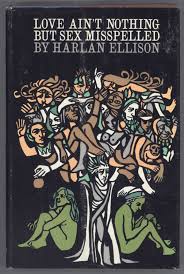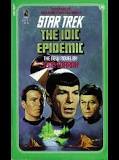 When his book Love Ain’t Nothing But Sex Misspelled came out in 1968, Harlan Ellison said that the title “reflects an attitude toward reality I would dearly love to see come to pass”. I disagreed — I still do — but it didn’t matter. Ellison was out there kicking American culture in the shins, and that was good enough for me. He was an angry man in an angry era.
When his book Love Ain’t Nothing But Sex Misspelled came out in 1968, Harlan Ellison said that the title “reflects an attitude toward reality I would dearly love to see come to pass”. I disagreed — I still do — but it didn’t matter. Ellison was out there kicking American culture in the shins, and that was good enough for me. He was an angry man in an angry era.
I never met the man and I stopped reading him after about 1970, so this is about early Ellison. He was a major part of my life through his short stories, still some of the best ever written, but I lost track of him about the time he went to Hollywood.
I read him through the time when I dumped God, watched blacks being fire-hosed in the deep South, escaped my parents, met up with the rest of the world, watched Americans on TV burning Viet Nam to the ground, and sat listening to the first draft lottery. My number was 41, by the way. Yikes! Everybody was angry on one side or the other of every issue (sound familiar?).
Through all this, Harlan Ellison was writing stories that kicked ass and took names. He was the perfect writer for the era.
He died yesterday (June 28th). I saw it this morning on a trailer sliding by under pictures of the latest atrocity on my morning news cast. I haven’t checked out the details yet. I don’t need to before writing this, because this is bibliography, not biography.
There were a lot of angry people writing things in the sixties. Most of them have been forgotten. Harlan is remembered because he made the things he wrote come real and resonate at a level beyond the moment. His short stories were the best I ever encountered, occasional clunker notwithstanding.
I went to my bookshelf and pulled out Paingod, I Have No Mouth & I Must Scream, The Beast that Shouted Love at the Heart of the World, From the Land of Fear, Earthman, Go Home, and Love Ain’t Nothing but Sex Misspelled. The first five are paperback. You can write them down when you finish reading and go to your neighborhood used book store, where the best in literature resides.
I say that because I just took a moment to check my local library’s online catalog. There are twelve entries on Ellison, all from late in his career, or things for which he wrote introductions. When he was hot, he was a newsstand sensation.
Newsstand: a place to buy newspapers, magazines, and paperback genre fiction. In other words, ephemera. You would never find War and Peace at a newsstand. You also wouldn’t find any of these books five months after they were published.
You will also find Ellison in a lot of anthologies beginning with the word Best . . .. He won a lot of Hugos and Nebulas, not always for his best work.
That’s it. The rest is a laundry list and the admonition to seek these out and read them. You’ll never find better.
Get Love Ain’t Nothing but Sex Misspelled and read it all, but pay particular attention to the Preface, and Pretty Maggie Moneyeyes. If you want to read the most honest writer’s autobiography ever submitted under the name of fiction, try Final Shtick.
Get as many of the others as you can still find. There will be some overlap since Love Ain’t . . . was mostly a self-chosen best-of. The gems awaiting you are not only the rest of the stories, but all of the highly personal introductions that never made it into Love Ain’t . . ..
I particularly recommend that you look at Earthman, Go Home to see what bad editing can do to a good writer. Not only was the original title Ellison Wonderland changed from something charming to something thumb-fingered dumb, but the cover contains every robot cliché that Ellison would never have used.


